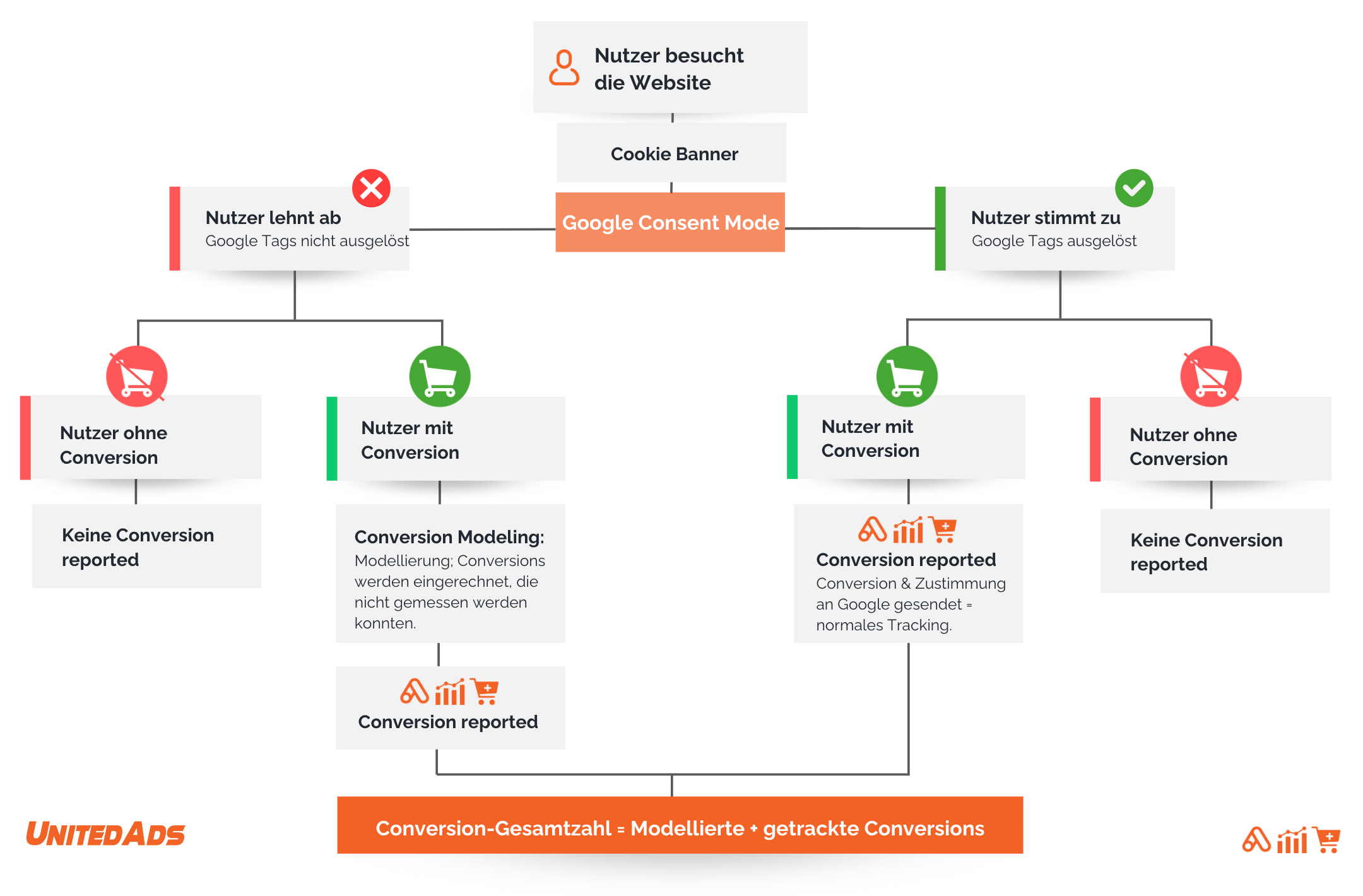If you want to use conversions via Google Ads or target groups in Google Analytics with as few restrictions as possible, you need to be prepared for changes to the current tracking setup. The reason for this is the Digital Markets Act (DMA) – the European Union’s law on digital markets. Among other things, the regulation sets out obligations for the providers of the largest online advertising programs and web analysis tools with marketing functions. This naturally includes Google Ads and Google Analytics. Specifically, Google must regulate how user data is handled for marketing and analysis purposes for advertisers and website operators. The individual’s “consent”, i.e. the decision to accept or reject the familiar cookie banner, will play a central role in this.
What will change in 2024?
Specifically, the upcoming changes for advertisers can be summarized in three major changes. These affect anyone who wants to use Google Ads or Google Analytics to make informed decisions about their own marketing measures based on data. The first major changes will take place as early as March 2024. Or as Google itself puts it: “This will be heavy”.
#1 Consent mode required for target group use (March 2024)
If you want to use first-party audiences and target groups from Google Analytics 4, you must activate the
Google Consent Mode
installed and correctly integrated with your cookie banner. This essentially affects all remarketing functions in Google Ads. These target group signals form, for example, the targeting of remarketing campaigns and the target group signals that are stored at the start of a Performance Max campaign. Without Consent Mode, the target groups will no longer be filled with new users from March 2024. In this case, functionality is only guaranteed until May/June 2024.
Google will complete the announced abolition of third-party cookies (third-party or targeting cookies) in its own Chrome browser as announced in July 2024. Other browsers, such as Safari or Firefox, already have stricter settings. The abolition of third-party cookies therefore comes as no surprise, but this may result in a loss of measurement of around 15%. This primarily concerns campaign setups in which remarketing and retargeting are used.
#3 No conversion tracking without consent mode (end of 2024)
It has already been announced and is therefore very likely that Google Ads Conversion Tracking (but also the performance measurement of Google Analytics 4) will no longer work without Google Consent Mode by the end of 2024.
What does the (new) Google Consent Mode do?
Since 2020 at the latest, it has been clear that the use of a cookie banner that takes the user’s decision (consent) into account is mandatory. Whether and which data is sent to Google Ads or Google Analytics after the consent decision often depended on the correct implementation of the banner. Google left the correct integration to the website operators – an error-prone solution in terms of data protection.
Google Consent Mode sends a signal to Google about the user’s consent decisions and changes the behavior of Google tags (Google Ads, Google Analytics, etc.) based on the user’s decision. Consent mode can also play an important role in modeling data that is lost, for example, when cookies are rejected. The current average rejection rate in Germany is 23%.
The graphic shows how the Consent Mode works to fill data gaps caused by rejection through modeling:

What is new is that Google is now splitting the Consent Mode into two different implementation modes. There is a Basic implementation and an Advanced implementation. From the name it can already be deduced that the advanced implementation provides more extensive functionality, especially with regard to marketing functions such as modeling data that cannot be measured via cookies. The basic version of Consent Mode, on the other hand, will only pass on data with the user’s consent. An overview of the functional scope of the versions illustrates the different levels:

It is extremely important for advertisers and website operators to bear in mind that Google will make Consent Mode mandatory for all conversion measurements by the end of 2024. The previous minimum required to be able to measure conversions in a compliant manner, for example via the Google Tag Manager, was the combination of cookie banner, Google website tag and the correspondingly set up conversion actions. The correctly set up Consent Mode should now be added in 2024. Google is already adding further consent types to the Consent Mode, which will map the graduated functionalities (click to expand):
A detailed overview of Consent Mode, the different types of consent and the effects of consent on behavior can be found at Google Developers. We are therefore facing the dawning era of measurement without cookies. With the help of so-called “pings” and modeling for consent mode, Google now provides differentiated options for compensating for data gaps (cookieless tracking).
What is the perfect conversion tracking setup for 2024?
Conversion tracking will also be more demanding in 2024. Advertisers with online marketers must be prepared for the fact that the actual measurable part of their conversions will continue to decrease. In order to reduce strong negative effects such as measurement gaps on your own CPA, ROAS or KUR, your own setup must be adapted. It is essential to use features such as Google Consent Mode in order to fill up non-measurable conversions through modeling.
The measures required for this can be categorized into 5 building blocks that decide whether you have a basic implementation or an advanced tracking setup including a strategy for modeling your data.
Finally, it remains to be said that in 2024 everyone will have to decide whether a basic implementation or an advanced implementation makes sense. For smaller websites or advertisers, even the basic requirements including Google Consent Mode present a new challenge. If you generate several thousand clicks a day, the requirements for the accuracy of the conversion data are higher. A measurement gap of a few percent can result in a large inaccuracy in conversions – with all the negative effects on the Google Ads bidding strategy. In this case, an advanced implementation, probably also with implementation of server-side tagging, is recommended.
Über den Autor
Philip ist Geschäftsführer und COO bei UnitedAds. Er ist Google Ads-Spezialist und Ansprechpartner für Lead Generation & International SEA

UnitedAds is your ideal partner for the
implementation of Google Consent Mode
to efficiently ensure data protection and user consent.
Rely on Unitedads for professional implementation of Google Consent Mode and strengthen your digital strategy in line with data protection standards.







